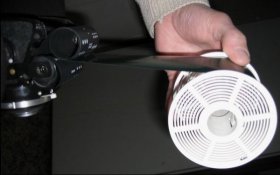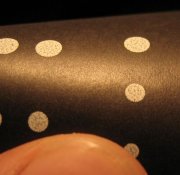sandermarijn
Member
I think I made some progress today. I developed three ‘no-camera’ Foma 100-120 films.
The first film was first unrolled to its full length (no cameras involved) and then exposed to a couple seconds of the artificial lighting in my darkroom. This film showed no scratches at all. This rules out as a cause for the scratches the entire chemical stage from developing onwards. Instead the problem seems to be with the camera or some other form of mechanical abuse during handling before or after exposure. This abuse could be my method of loading the film into the reels of the developing tank.
What I do is that I put the film in an old medium format camera (Agfa Clack) and then pull out the film and wind it up the reel (see picture in attachment). Something that never occurred to me before is that during this process, the paper backing curls up against the film and slips against it. This ‘brushing’ of the film does not seem to involve much force. However, the backing is rather rough and stiff (much stiffer and rougher than the paper from the big brands). It’s not exactly sandpaper, but in relative terms it is (see close-up in attachment). It seems entirely possible that the rubbing causes the scratches.
Unfortunately I do not have my cameras (apart from the Clack) in the location of my darkroom. (My darkroom is in my parents’ house and I live 15 km away from there in a place too small for a darkroom.) Therefore I could not load a film into any of the cameras that I normally use and that gave me the pictures with scratches.
I loaded a film into the Clack instead and wound that onto the take-up spool, in order to simulate the forces that the film feels in the other cameras. Then I loaded the film into the developing reel, just like with the previous film, i.e. with the ‘sandpaper’ rubbing against the film. I did the loading in daylight so that the film got its exposure.
This film did show scratches, identical to the ones I had before. Interestingly, the scratches were not homogeneously spread over the film, but grouped in batches a few centimetres apart from each other.
Did the scratches come from the rubbing of the backing paper against the film or from friction during transport inside the camera?
The third film I wound onto an empty spool first, very gently and by hand, not inside any camera. Then I put that second spool into the Clack and loaded it into the developing reel from there, i.e. with the paper backing rolling/rubbing against the film. In addition I extra-rubbed the backing paper against the last part of the film, like when using sandpaper on wood or something.
This film also showed scratches, but no extra scratches where I extra-rubbed the film. Maybe I rubbed the wrong side of the film?
The conclusion from this last film seems to be that the rolling/rubbing of the backing paper against the film (as in the first attachment) is enough to produce scratches. The question is now if a film that was wound/exposed inside a camera will show scratches even if the backing paper never rubs against it like in the picture.
Tomorrow I will shoot a film inside a camera (Hasselblad 500cm) and develop it. If it shows scratches then those are caused by transport (friction) of the film inside the camera. If it doesn’t show scratches then my reel-loading method (where the backing paper rubs against the film) is to blame.
What to think of all this? Fomapan 100-120 seems a very vulnerable film, a bit too much so I think. Even if I manage to eliminate the cause of the scratching then will I ever have full confidence that they won’t show up again at some unfortunate moment? Why does Foma use backing paper that is so rough? I just did a little test: if I rub Foma backing paper against Foma film then that film is very visibly damaged, but if I do the same thing with Fuji backing paper against Foma film then the film is completely undamaged. This Foma backing paper really is a liability.
I will post more results tomorrow (for myself and for those interested in more scratches).
The first film was first unrolled to its full length (no cameras involved) and then exposed to a couple seconds of the artificial lighting in my darkroom. This film showed no scratches at all. This rules out as a cause for the scratches the entire chemical stage from developing onwards. Instead the problem seems to be with the camera or some other form of mechanical abuse during handling before or after exposure. This abuse could be my method of loading the film into the reels of the developing tank.
What I do is that I put the film in an old medium format camera (Agfa Clack) and then pull out the film and wind it up the reel (see picture in attachment). Something that never occurred to me before is that during this process, the paper backing curls up against the film and slips against it. This ‘brushing’ of the film does not seem to involve much force. However, the backing is rather rough and stiff (much stiffer and rougher than the paper from the big brands). It’s not exactly sandpaper, but in relative terms it is (see close-up in attachment). It seems entirely possible that the rubbing causes the scratches.
Unfortunately I do not have my cameras (apart from the Clack) in the location of my darkroom. (My darkroom is in my parents’ house and I live 15 km away from there in a place too small for a darkroom.) Therefore I could not load a film into any of the cameras that I normally use and that gave me the pictures with scratches.
I loaded a film into the Clack instead and wound that onto the take-up spool, in order to simulate the forces that the film feels in the other cameras. Then I loaded the film into the developing reel, just like with the previous film, i.e. with the ‘sandpaper’ rubbing against the film. I did the loading in daylight so that the film got its exposure.
This film did show scratches, identical to the ones I had before. Interestingly, the scratches were not homogeneously spread over the film, but grouped in batches a few centimetres apart from each other.
Did the scratches come from the rubbing of the backing paper against the film or from friction during transport inside the camera?
The third film I wound onto an empty spool first, very gently and by hand, not inside any camera. Then I put that second spool into the Clack and loaded it into the developing reel from there, i.e. with the paper backing rolling/rubbing against the film. In addition I extra-rubbed the backing paper against the last part of the film, like when using sandpaper on wood or something.
This film also showed scratches, but no extra scratches where I extra-rubbed the film. Maybe I rubbed the wrong side of the film?
The conclusion from this last film seems to be that the rolling/rubbing of the backing paper against the film (as in the first attachment) is enough to produce scratches. The question is now if a film that was wound/exposed inside a camera will show scratches even if the backing paper never rubs against it like in the picture.
Tomorrow I will shoot a film inside a camera (Hasselblad 500cm) and develop it. If it shows scratches then those are caused by transport (friction) of the film inside the camera. If it doesn’t show scratches then my reel-loading method (where the backing paper rubs against the film) is to blame.
What to think of all this? Fomapan 100-120 seems a very vulnerable film, a bit too much so I think. Even if I manage to eliminate the cause of the scratching then will I ever have full confidence that they won’t show up again at some unfortunate moment? Why does Foma use backing paper that is so rough? I just did a little test: if I rub Foma backing paper against Foma film then that film is very visibly damaged, but if I do the same thing with Fuji backing paper against Foma film then the film is completely undamaged. This Foma backing paper really is a liability.
I will post more results tomorrow (for myself and for those interested in more scratches).




















